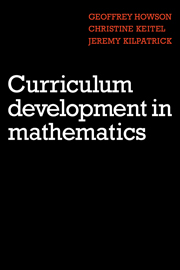Book contents
- Frontmatter
- Contents
- Preface
- 1 Curriculum development: an introduction
- 2 The historical background
- 3 Case studies of curriculum development
- 4 The practice and management of curriculum development
- 5 Curriculum theory and curriculum research
- 6 A retrospective look at curriculum projects
- 7 Evaluation within curriculum development
- 8 Lessons for today and tomorrow
- Appendix 1
- Appendix 2
- Bibliography
- Index
6 - A retrospective look at curriculum projects
Published online by Cambridge University Press: 05 October 2010
- Frontmatter
- Contents
- Preface
- 1 Curriculum development: an introduction
- 2 The historical background
- 3 Case studies of curriculum development
- 4 The practice and management of curriculum development
- 5 Curriculum theory and curriculum research
- 6 A retrospective look at curriculum projects
- 7 Evaluation within curriculum development
- 8 Lessons for today and tomorrow
- Appendix 1
- Appendix 2
- Bibliography
- Index
Summary
The reform period in the USA
For many years behaviourist learning theory had little impact on curriculum discussion, for this was dominated by the ideas of Dewey's school whose child-centredness was more appealing than the behaviourist emphasis on the meeting of society's demands. Behaviourist theory was also noticeably deficient in that it had to leave open many questions regarding the hierarchical organisation of the objective goals and their applicability, questions to which answers were not given until Bloom's taxonomy (Bloom et ai. 1956) and Gagné's types of learning (1962). World War II was, however, to produce a marked swing in favour of the behaviourist approach. There were several reasons for this.
One was the way in which society's demands on education came to assume far greater significance and to prevail over those objectives which were directed at individual needs. Again, investigations carried out in the armed services into the educational level of their recruits exposed a disastrous ignorance of mathematics and the sciences which was widely attributed to the failure of the liberal–pragmatic education to transmit knowledge and skills. There was an urgent need to repair such failings and here the behaviourist methods of training seemed particularly apposite. Moreover, in the limited way in which they were employed they proved highly effective. Thus it was that behaviourist methods came to be used in military and business circles before they entered schools.
Information
- Type
- Chapter
- Information
- Curriculum Development in Mathematics , pp. 131 - 181Publisher: Cambridge University PressPrint publication year: 1981
